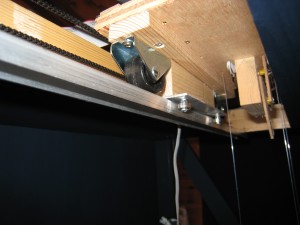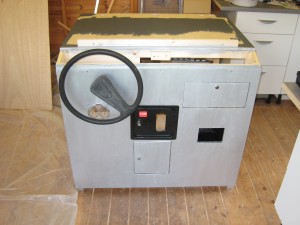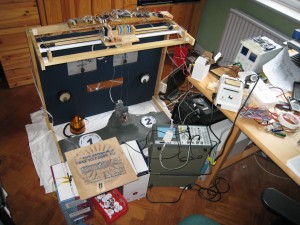-
Three wheels good, four wheels bad
Posted on May 30th, 2009 No commentsLunar Lander is basically finished – just chasing the final bugs out. It will be on Southwold Pier soon. This phase of the build is really painful. You want to just relax and enjoy the job being finished. Instead there seems to be a never-ending list of niggles to tackle. The thought that gives me focus for all this is that it’s a lot easier to fix things at home than it is once the machine is over the other side of the country.
Today I did what I hope is the last major mechanical change. The linear bearing build around a DIY store towel rail was proving unreliable. The slide mechanism would randomly stick and sometimes stall the horizontal motor. In the true modern style I first went for the “if the hardware is broke, fix it in software” approach and slowed the maximum speed of the motor down to see if that helped. No luck unfortunately, so I decided to build a new bearing for the carriage to run on. The design I ended using was in fact the original one I intended to use but had rejected in favour of the towel rail. The new one uses a piece of aluminium angle as a guide with ball bearings to follow. First signs are that this new design is a lot smoother.

New Lunar lander bearing
Anyway, you might ask – where does the three wheels come in? As you might imagine, building with hand tools you can only achieve a certain level of accuracy. I normally aim for a 1mm tolerance unless I know I need something better. This creates a problem for modules that move on four wheels. Often you find that only three are in contact with the base at any one time, and it rocks back and forward like a dodgy pub table. I forgot this problem when I built the new carriage and initially gave it four wheels. Of course they didn’t fit properly and it moved annoyingly.
As anyone who’s studied 3D geometry knows, three points in space define a plane. Therefore modules that move on three wheels are always in contact with their base on all their wheels (unless they over balance of course). Lunar Lander ended up using this in two places. The redesigned carriage is a three wheeler and so is the disk for the badge dispenser. The problem with three wheels is that you need to think about the weight distribution carefully to prevent the whole module falling over. Keep the centre of gravity within the triangle defined by the wheels.
There is an irony in replacing the towel rail bearing – the dimensions of the original towel rail pretty much defined all the critical dimensions for the finished machine. Now it’s gone – taking the original rational for many of the design choices with it. Oh well, at least the new bearing fitted nicely in the original space.
-
Just a lick of paint and unexpected problems
Posted on May 4th, 2009 No commentsLunar lander is in in the home straight now (I hope)!
Most of the major cabinet work is done and paint has even been applied to most of it. Going for a “space age” silver which certainly hits the retina. The single spoke 2CV steering wheel gives it a certain panache to go with the “made in my shed” look.

Lander Cabinet Base
As well as fun stuff like mounting the wheel the end forces you to do all the tedious things that you’ve ignored so far. In my case this meant adding proper handling for errors detected by the motor controls and designing labels for the cabinet and so on.
It’s also at this stage that nasty surprises crop up. I managed to break the winding mechanism by bashing it on the top of the cabinet. Then the repaired mechanism started to slip and had to be redesigned. Lastly I’ve got a “fuzz light” of ebay which is supposed to warn the operators of any problems with the machine. Trouble is it’s cheapo motor creates so much electrical noise that every time it switches on it scrambles all the control electrics. So far all attempts to fix it have failed. I am learning a lot about managing noise when interfacing microcontrollers to high current devices, but that isn’t really the goal of the exercise at this point.
Good news though – with almost all the lighting installed the game looks fab. The colour and visual impact of the back-lit main meters (speed and fuel) is great.
Still a few loose ends on the software – mainly creating the “idle mode” that will run to attract attention when nobody is playing the game. This means that the moving parts of the game and all the essential peripherals are packed in to my study.


